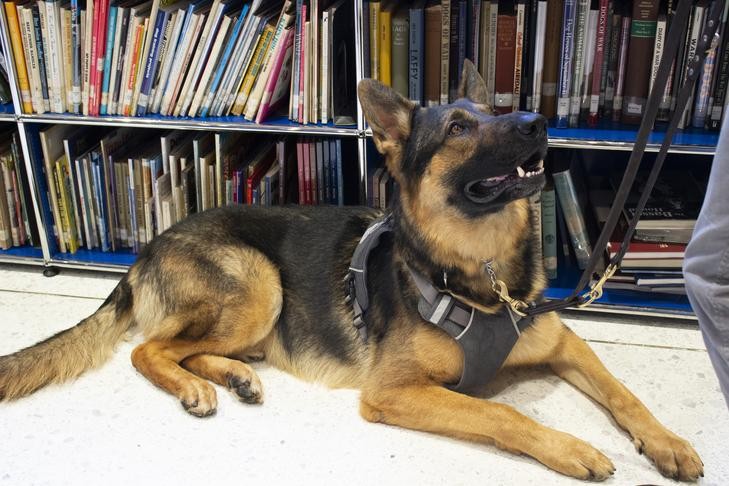Guide dogs are more than just pets; they are highly trained service animals that provide invaluable assistance to individuals with visual impairments. You may have seen them assisting their handlers in public, but there’s much more to understand about their crucial role and the extensive training they undergo. This guide delves into the world of guide dogs, exploring their selection, training, and the profound impact they have on their handlers’ lives.
1. The Meticulous Pairing Process
The selection of a guide dog for a handler is a carefully considered process, taking into account various aspects of the individual’s lifestyle. Non-profit organizations meticulously match dogs with applicants based on their needs and circumstances.
Lorri Bernson, media and community liaison at Guide Dogs of America, emphasizes the importance of a harmonious match: “Do you have kids? Do you have other animals in your house? All of that goes into account of whether the dog will work for the person, and if the dog will be happy, as well. The dogs are personally chosen for specific people.” This holistic approach ensures the well-being of both the dog and the handler.
2. Bonding and Ongoing Training
The partnership between a guide dog and its handler is built on a strong bond formed through extensive training. Organizations facilitate this bond through dedicated training programs at their facilities, where dogs and handlers learn to work together under the guidance of professionals.
Michelle Barlak, senior associate of public relations at The Seeing Eye, highlights the importance of the relationship: “Many people believe that anyone can pick up the harness, and the dog will just guide them. In truth, the dog must bond with his owner, and they must form a relationship. The dogs work for their owner’s praise and affection.” This bond is essential for effective communication and trust between the dog and its handler.
3. Popular Breeds for Guide Dogs
Certain breeds are commonly chosen for guide dog work due to their temperament, trainability, and physical characteristics. German Shepherd Dogs, Labrador Retrievers, and Golden Retrievers are among the most popular choices. Standard Poodles are also sometimes used, particularly for individuals with allergies.
Breed characteristics are a key consideration when pairing dogs with people, with more active breeds often matched with more active individuals. Ultimately, the success of a guide dog team hinges on the bond between the dog and the handler, as Bernson from Guide Dogs of America explains.
4. Early Training and Socialization
The training and socialization of guide dogs begin at a very young age. Many organizations have their own breeding programs, ensuring that puppies are raised in an environment conducive to developing the necessary skills and temperament.
At around 8 weeks old, puppies are placed with puppy raisers, who are responsible for socializing them and teaching basic obedience. This early socialization is crucial for exposing the puppies to a variety of environments and situations, preparing them for their future roles as guide dogs.
Between 12 and 18 months old, the dogs return to the organization for formal guide dog training with professional instructors. This intensive training can last for several months, as the dogs progress through various levels of training before being paired with a blind handler.
5. Directional Cues and Intelligent Disobedience
Guide dogs are not GPS devices; they rely on directional cues from their handlers. They are trained to intelligently disobey commands if they detect an unsafe situation in the handler’s path.
Barlak from The Seeing Eye explains, “Seeing Eye dogs are not like using a GPS. The dog’s job is to look out for hazards and obstacles that the blind person cannot detect, such as a blocked path or an overhead obstruction.”
Guide dogs cannot read traffic lights; the handler is responsible for listening to the flow of traffic and giving the dog a command to cross when it sounds safe. The dog must then decide if it is safe to cross, demonstrating the critical decision-making ability that is essential for protecting their handler. The handler must trust the dog’s judgement.
6. Respecting Working Guide Dogs
When a guide dog is wearing its harness, it is working and should not be petted or distracted. It’s important to resist the urge to pet these friendly animals when they are performing their duties.
Bernson from Guide Dogs of America emphasizes this point: “[Many people don’t know] not to pet guide dogs while they are in a harness, but they are working and it could distract them from their job.”
7. Life-Changing Independence
Guide dogs provide a profound sense of independence and mobility to their handlers, far exceeding what a cane can offer. The constant companionship of a trustworthy and loyal canine can transform lives.
Jen Armbruster, a gold medal Paralympian who has used multiple guide dogs since becoming blind at age 17, describes the feeling: “It’s just such a feeling of freedom and independence. Using the cane was a reality check for me of how much freedom that dog gave me.”
In conclusion, guide dogs are indispensable partners for individuals with visual impairments, offering not only guidance but also companionship and a renewed sense of independence. The rigorous training, careful selection, and strong bond between dog and handler contribute to a truly remarkable partnership.
